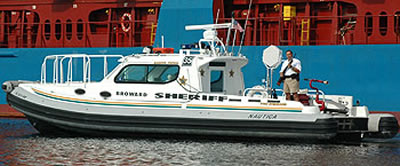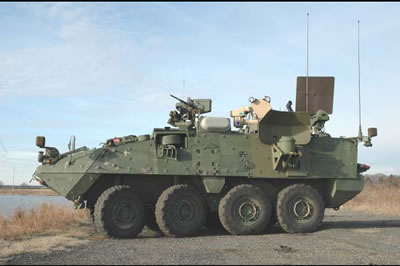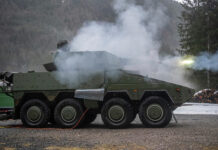 LRAD – is a long-range hailing and warning, directed acoustic device designed to communicate with authority and exceptionally high intelligibility in a 15-30 degree beam. LRAD can issue a verbal challenge with instructions in excess of 500 meters and has the capability of following up with a warning tone to influence behavior or determine intent. The “hailing and warning” application for commercial shipping is similar to the successful LRAD deployments by the U.S. Navy on patrol craft in and around the port of Basra, Iraq to communicate with vessels in shipping lanes and around oil terminals, where the device was reported to be effective even at a distance of 1,000 meters. LRAD was originally conceived to support the protection and exclusion zones around U.S. Navy warships. The challenge of interdicting small boats approaching commercial maritime assets is quite similar. LRAD’s warning tones command attention at ranges in excess of 500 meters while its directional and highly intelligible voice instructions can unquestionably be heard. LRAD’s ability to positively communicate with authority on land or at sea is proving highly effective in creating safe situations out of uncertain ones.
LRAD – is a long-range hailing and warning, directed acoustic device designed to communicate with authority and exceptionally high intelligibility in a 15-30 degree beam. LRAD can issue a verbal challenge with instructions in excess of 500 meters and has the capability of following up with a warning tone to influence behavior or determine intent. The “hailing and warning” application for commercial shipping is similar to the successful LRAD deployments by the U.S. Navy on patrol craft in and around the port of Basra, Iraq to communicate with vessels in shipping lanes and around oil terminals, where the device was reported to be effective even at a distance of 1,000 meters. LRAD was originally conceived to support the protection and exclusion zones around U.S. Navy warships. The challenge of interdicting small boats approaching commercial maritime assets is quite similar. LRAD’s warning tones command attention at ranges in excess of 500 meters while its directional and highly intelligible voice instructions can unquestionably be heard. LRAD’s ability to positively communicate with authority on land or at sea is proving highly effective in creating safe situations out of uncertain ones.
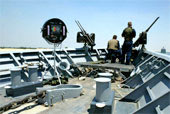 On November 7, 2005 LRAD was first used to foil a pirate attack on a Seabourn Cruise Line luxury cruise. The system was installed as a part of the ship’s defense systems, and was activated when pirates attacked the ship with RPGs 160 kilometers off the Somali coast . The pirates failed to board the cruiser. LRAD’s maritime application was realized after the 2000 attack on the USS Cole off Yemen, as a way to keep operators of small boats from approaching US warships. The system was evaluated by commercial ship operators, as a non lethal way to ward off pirate attacks. Other applications include armed unmanned surface vehicles, as international maritime law does not allow commercial vessels to carry heavy armament.
On November 7, 2005 LRAD was first used to foil a pirate attack on a Seabourn Cruise Line luxury cruise. The system was installed as a part of the ship’s defense systems, and was activated when pirates attacked the ship with RPGs 160 kilometers off the Somali coast . The pirates failed to board the cruiser. LRAD’s maritime application was realized after the 2000 attack on the USS Cole off Yemen, as a way to keep operators of small boats from approaching US warships. The system was evaluated by commercial ship operators, as a non lethal way to ward off pirate attacks. Other applications include armed unmanned surface vehicles, as international maritime law does not allow commercial vessels to carry heavy armament.
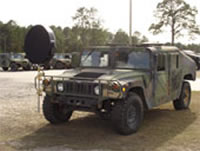 LRADs and its scale-down Medium Range Acoustic Device (MRAD) (shown above), are currently deployed with the coast guard, U.S. Marine Corps, U.S. Army, and U.S. Navy in Operation Iraqi Freedom in and around Fallujah, Mosul, and the port of Basra. Most recently, over $600,000 worth of products were procured for the Army’s 3rd Armored Cavalry Regiment. Recent deliveries were made to the 44th Engineering Battalion, deployed in central Iraq and the 3rd Infantry Division will be utilizing LRADs in Iraq for crowd control, area denial and clearing buildings. The smaller MRAD is optimized for land and vehicle-based operations. It can be employed from armored vehicles, for urban warfare, shorter-range checkpoints and security. A larger, more powerful Extended Range Acoustic Device (ERAD), can also be used to supports very long distance communications for the critical infrastructure, including border security.
LRADs and its scale-down Medium Range Acoustic Device (MRAD) (shown above), are currently deployed with the coast guard, U.S. Marine Corps, U.S. Army, and U.S. Navy in Operation Iraqi Freedom in and around Fallujah, Mosul, and the port of Basra. Most recently, over $600,000 worth of products were procured for the Army’s 3rd Armored Cavalry Regiment. Recent deliveries were made to the 44th Engineering Battalion, deployed in central Iraq and the 3rd Infantry Division will be utilizing LRADs in Iraq for crowd control, area denial and clearing buildings. The smaller MRAD is optimized for land and vehicle-based operations. It can be employed from armored vehicles, for urban warfare, shorter-range checkpoints and security. A larger, more powerful Extended Range Acoustic Device (ERAD), can also be used to supports very long distance communications for the critical infrastructure, including border security.
LARD can be integrated with the Phraselator, a hand-held voice translation device, which is a key tool to store and immediately retrieve thousands of messages recorded by the Defense Language Institute for transmission through LRAD at extended ranges in the host nation language. This capability is being implemented with each LRAD delivered in this order and augments ATC’s hardened MP3 player used for messaging and instantly-available aversive warning tones.
According to Defense Update reader Michael Frank of Phodio Ltd. an international LRAD distributor from the UK, LRAD has been in use for years, for military purposes and to avoid maritime piracy and to control and give information to big crowds, riots and demonstrations. “You should see the LRAD as a kind of megaphone rather than a non-lethal weapon” says Frank. “It gives normal acoustic messages, however good engineering work have made it possible to narrow the sound beam. It is also a fact it can make an ear-splitting noise that nobody can stand.” Nevertheless, it is mainly used is to communicate and to give information in long distance in high ambient noise environment.” The system is effective for vocal communications at distances of several hundreds meter distance, a capability which can also be used in disaster area.




